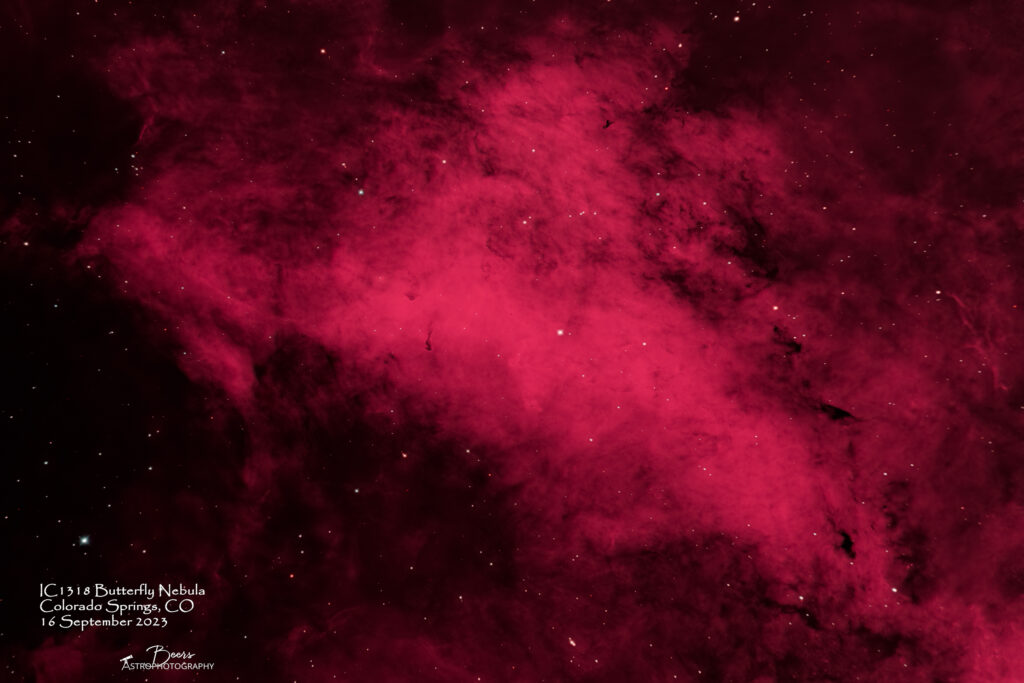IC1318 Gamma Cygni Nebula (a.k.a. (one of several) Butterfly Nebula) was captured during a dual-setup data collection frenzy from the front patio on the one clear night sandwiched between a week of rainy, stormy weather and departing for a business trip. Definitely a placeholder waiting for the opportunity to capture this image in dark skies to see what the colors really are!
IC1318 Gamma Cygni Nebula (a.k.a. Butterfly Nebula)

IC1318 Gamma Cygni Nebula (a.k.a. Butterfly Nebula)
Target Fun Facts: The Gamma Cygni Nebula, also known as the Sadr Region or IC 1318, is a diffuse emission nebula that can be seen around Sadr (γ Cygni), the star at the center of the Northern Cross, which marks the heart of Cygnus, the Swan. Despite the name, the star and the nebula are unrelated. Even though it looks embedded in the nebulosity, Sadr (which is not captured in my image) is approximately 1,800 light years distant, while the nebula is much further away, at 4,900 light years.
The Gamma Cygni Nebula has three distinct parts, designated as IC 1318 A, B and C. The dark cloud about 20 light years thick that divides IC 1318 B and C is a dark nebula known as LDN 889. It is physically related to the emission nebula and the surrounding molecular cloud complex. The dark dust lane is responsible for the nebula’s distinctive shape, resembling that of a butterfly, which is why IC 1318 is sometimes also known as the Butterfly Nebula. IC 1318 is not to be confused with several other DSO’s with the same name: the Butterfly Nebula (NGC 6302), a bipolar planetary nebula located in the constellation Scorpius; the bright planetary Butterfly Nebula (NGC 2346) in Monoceros constellation; or the planetary nebula known as Minkowski’s Butterfly (M2-9) or the Twin Jet Nebula located in Ophiuchus.
Capture Notes: This was captured on Saturday night (16Sep2023), the clear night after a long wet, rainy, cloudy, stormy spell and before I left for a week of business travel. I got a second Optilong LeXtreme filter, the ASI2400MC DC power cable from Tolga, and Paul finished up the “Chile” battery so with that I now have two of everything and can run two rigs simultaneously. That is exactly what I did – taking full advantage of the one night I had! I’m having issues with coma with the ASI2400 and Big Bertha (8″ R-C). The field flattener I bought works really well correcting the coma with the 10″R-C but makes the situation worse on the 8″ R-C I’m wondering if it is my current, hokey “pulling the connection tube partway out to focus” that I’m having to do right now until the real extension tube arrives (now that I’ve finally convinced Orion that I need it and that they should sell it to me – but that’s another story!). I’m thinking there might be a slight non-parallel-ness to the setup that’s causing the issue?? It’s always something – right??
Processing Highlights: As usual, I captured the data with SGP, removed stars with Starnet++, and processed with LR/PS.
But, I decided to give Nico Carver’s dual narrowband colorizing technique (3 Ways to edit Dual Narrowband Astrophotography! at https://www.youtube.com/watch?v=hLGjXJ3FxO0&t=2181s) a try with this image. I’m not certain the “juice is worth the squeeze” at least for this image (my one and only data point thus far) as compared to the workflow I have been using for enhancing tone and color (taking the almost finished nebula-only image into LR and use the Alyn Wallace presets (https://alynwallacephotography.com/astro-workflow-lightroom-presets) that I finally broke down and bought earlier this year. There was a lot of signal in the green and blue channels, but is dominated by the Ha signal in the Red channel at exactly the same spots – so all I got was tone/hue/overall color changes (with some very hideous looking ones during the process). So, I’m guessing that when all the signal is in the same spot separating out and putting back together doesn’t have much effect – and the Ha signal will continue to dominate.
I’m not sure I like the magenta tones I ended up with, but after fiddling with it for a couple of hours – I’m calling this a “front patio placeholder” and adding to my “reshoot in dark skies” list… The gallery entry, for the “rest of the story” is here: https://beersastrophotography.com/gallery/ic1318-gamma-cygni-nebula-butterfly-nebula/
